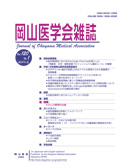

Journal of Okayama Medical Association
Published by Okayama Medical Association<Availability>
Full-text articles are available 3 years after publication.
Permalink : http://escholarship.lib.okayama-u.ac.jp/19505
悪露に関する研究 第1編 悪露の量
鳥取 行雄
岡山大学医学部産科婦人科学教室
発行日
1959-04-15
抄録
This study was undertaken to establish the amount of lochia of Japanese, and conducted on 512 unselected patients who were delivered in the Maternity Hospital of Okayama University School of Medicine. The pads employed were preserved in caped-bottle after having lochia absorbed, and weighed daily as those of 24 hours during the 7 days of postpartum. The rate of evaporation at the time of weighning was 5.5%, including both on the external genital organs and in the bottle. The measurement was begun 2 hours after the delivery. The sampling results derived from this observation are as follows, 1) The amount of lochia shows the regular distribution. 2) The rely-bounds are obtained as 286.0±10.1g, throughout all cases, and 268.0±12.0g in 182 untreated normal deliveries. 3) The more abundant amount was obtained in the groups of toxemia of pregnancy and forceps delivery as compared with the untreated normal group, and the less, contrary to this in premature delivery and cesarean section groups. 4) The primiparous was more abundant in amount than the multiparous. 5) The elder the maternal and fetal ages are, the more in amount is obtained. 6) There were found no influence to the quantity by the amount of hemorrhage at the time of labor, and the length of labor. 7) The period of leaving from bed and the administration of uterotonics has no influence to the lochial amount. 8) The amount increases with the weight of the placenta. 9) The less adequate the involution of the uterus at the time of the 7 th day of postpartum is, the less in the quantity. As has been described above, it was confirmed that the quantity of lochia of Japanese is far less than those of 500 to 1000g stated hitherto in the text-books, and, moreovere, influenced by various factors. On account of the definite relationship of lochial quantity to the course of puerperum, the author believes that the lochial amount be able to be one of the critical basis for the process of the involution in the genital organs.
ISSN
0030-1558
NCID
AN00032489
